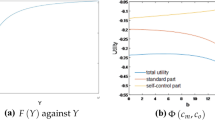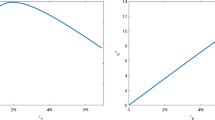Abstract
Mandatory pension systems partially replace old-age income, therefore the government matches additional life-cycle savings in a voluntary pension system. Though the individual saving decisions are apparently independent, the earmarked taxes (paid to finance the matching) connect them. Previous models either neglected the endogenous tax expenditures (e.g. Choi et al., in: Wise (ed) Perspectives in the economics of aging, University of Chicago Press, Chicago, pp 81–121, 2004) or assumed very sophisticated saving strategies (e.g. Fehr et al. in FinanzArchiv Pub Finance Anal 64:171–198, 2008). We create twin models: myopic workers learn (i) from farsighted workers using public information (analytic model) and (ii) also from each other (agent-based model). These models provide more realistic results on saving behavior and the impact of matching on the income redistribution than the earlier models.






Similar content being viewed by others
Notes
In a previous version, Király and Simonovits (2016) used the expression global learning for learning by using public information.
For example, in a calibrated general equilibrium model of the German economy, Fehr et al. (2008) showed that if the voluntary pillar is extended, then existing generations lose and future generations gain. In addition, the assumption of rational expectations makes the foregoing models extremely complex (for an alternative with naive expectations, see Molnár and Simonovits 1998).
For the sake of simplicity, we forbid shortsighted workers to learn from farsighted workers but as suggested personally by Botond Kőszegi, its inclusion would open the door to an alternative learning mechanism not using government-made information like \(\alpha \) and especially \(\theta \).
Note that even extending the rules to allow learning from farsighted workers would not significantly improve learning. Upon request, we can send an unpublished document showing this.
References
Auerbach AJ, Kotlikoff LJ (1987) Dynamic fiscal policy. Cambridge University Press, Cambridge
Baily MN, Kirkegaard JF (2009) US pension reform: lessons from other countries. Petersons Books, Washington D.C
Barr N, Diamond P (2008) Reforming pensions: principles and policy choices. Oxford University Press, Oxford
Bertotti ML, Modanese G (2016) Mathematical models describing the effects of different tax evasion behaviors. J Econ Interact Coord. https://doi.org/10.1007/s11403-016-0185-9
Chetty R (2015) Behavioral economics and public policy: a pragmatic approach. Am Econ Rev Papers Proc 105:1–33
Choi J, Laibson D, Madrian B, Metrick A (2004) For better or worse: default effects and 401(k) saving behavior. In: Wise D (ed) Perspectives in the economics of aging. University of Chicago Press, Chicago, pp 81–121
Duflo E, Saez E (2003) The role of information and social interaction in retirement decisions. Quart J Econ 111:815–842
Duflo E, Gale W, Liebman J, Orszag P, Saez E (2007) Saving incentives for low- and moderate income families in the United States: why is saver’s credit not more effective? J Eur Econ Assoc 5:647–661
Engen EM, Gale WG, Scholz J (1996) The illusory effects of saving incentives on saving. J Econ Perspect 10(4):111–138
Erdős P, Rényi A (1959) Random graphs I. Publ Math 6:290–297
Fehr H, Habermann C, Kindermann F (2008) Tax-favored retirement accounts: are they efficient in increasing savings and growth? FinanzArchiv Pub Finance Anal 64:171–198
Feldstein MS (1985) The level of social security benefits. Q J Econ 100:302–320
Hinz R, Holzmann R, Tuesta D, Takayama N (eds) (2013) Matching contributions for pensions. World Bank, Washington D.C
Hubbard RG, Skinner JS (1996) Assessing the effectiveness of saving incentives. J Econ Perspect 10(4):73–90
Király B, Simonovits A (2016) Saving and taxation in voluntary pension systems: toward an agend-based model. IE-CERS-HAS Working Paper, 6
Lusardi A, Mitchell O (2014) The economic importance of financial literacy: theory and evidence. J Econ Lit 52:5–44
Méder Zs, Simonovits A, Vincze J (2012) Tax morale and tax evasion: social preferences and bounded rationality. Econ Anal Policy 42:171–188
Modigliani F, Brumberg R (1954) Utility analysis and the consumption function: an interpretation of cross-section data. In: Kurihara KK (ed) Post-Keynesian economics. Rutgers University Press, New Brunswick, pp 388–436
Molnár Gy, Simonovits A (1998) Expectations, (in)stability and (in)viability in realistic overlapping cohorts models. J Econ Dyn Control 23:303–332
OECD (2005) Tax-favored retirement saving. OECD Economic Studies, 39, Paris
Pickhard M, Prinz A (2013) Behavioral dynamics of tax evasion - a survey. J Econ Psychol 39:45–60
Poterba JM, Venti SF, Wise DA (1996) How retirement saving program increase saving. J Econ Perspect 10(4):91–112
Samuelson PA (1958) An exact consumption-loan model of interest with or without the social contrivance of money. J Polit Econ 66:467–482
Simonovits A (2011) When are voluntary pensions indifferent. Econ Lett 111:153–155
Tesfatsion L (2006) Agent-based computational economics: a constructive approach to economic theory. In: Tesfatsion L, Judd KL (eds) Handbook of computational economics, vol 2. Elsevier, Amsterdam, pp 831–880
Thaler RH, Benartzi Sh (2004) Save more tomorrow: using behavioral economics to increase employee saving. J Polit Econ 112:S164–S187
Varga G, Vincze J (2017) Savers types: an evolutionary-adaptive approach. IE-CERS-HAS Working Paper 2
Acknowledgements
We thank Cars Hommes, Botond Kőszegi, Gergely Varga, Tamás Vicsek, János Vincze and the anonymous referees of this Journal for their useful comments, especially for calling our attention to the imperfect formulation of the transition from zero to positive matching in Király and Simonovits (2016) which is longer and can be found on the web. We express our gratitude for the generous grant of the Hungarian Research Foundation (OTKA) under grant number 108668.
Author information
Authors and Affiliations
Corresponding author
Electronic supplementary material
Below is the link to the electronic supplementary material.
Rights and permissions
About this article
Cite this article
Király, B., Simonovits, A. Learning to save in a voluntary pension system: toward an agent-based model. J Econ Interact Coord 14, 121–145 (2019). https://doi.org/10.1007/s11403-018-0218-7
Received:
Accepted:
Published:
Issue Date:
DOI: https://doi.org/10.1007/s11403-018-0218-7




